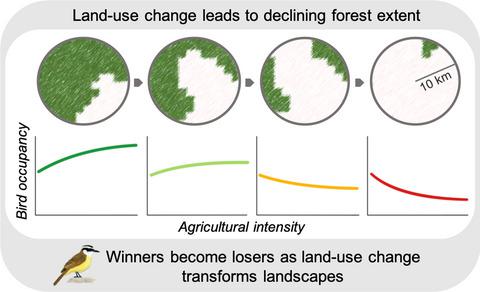当前位置:
X-MOL 学术
›
J. Appl. Ecol.
›
论文详情
Our official English website, www.x-mol.net, welcomes your
feedback! (Note: you will need to create a separate account there.)
Trade‐offs between biodiversity and agriculture are moving targets in dynamic landscapes
Journal of Applied Ecology ( IF 5.0 ) Pub Date : 2020-07-21 , DOI: 10.1111/1365-2664.13699 Leandro Macchi 1 , Julieta Decarre 2 , Andrea P. Goijman 2 , Matías Mastrangelo 3 , Pedro G. Blendinger 1 , Gregorio I. Gavier‐Pizarro 2 , Francisco Murray 4 , María Piquer‐Rodriguez 1 , Asunción Semper‐Pascual 5 , Tobias Kuemmerle 5, 6
中文翻译:

生物多样性与农业之间的权衡是动态景观中的移动目标
更新日期:2020-07-21
Journal of Applied Ecology ( IF 5.0 ) Pub Date : 2020-07-21 , DOI: 10.1111/1365-2664.13699 Leandro Macchi 1 , Julieta Decarre 2 , Andrea P. Goijman 2 , Matías Mastrangelo 3 , Pedro G. Blendinger 1 , Gregorio I. Gavier‐Pizarro 2 , Francisco Murray 4 , María Piquer‐Rodriguez 1 , Asunción Semper‐Pascual 5 , Tobias Kuemmerle 5, 6
Affiliation

|
- Understanding how biodiversity responds to intensifying agriculture is critical to mitigating the trade‐offs between them. These trade‐offs are particularly strong in tropical and subtropical deforestation frontiers, yet it remains unclear how changing landscape context in such frontiers alters agriculture–biodiversity trade–offs.
- We focus on the Argentinean Chaco, a global deforestation hotspot, to explore how landscape context shapes trade‐off curves between agricultural intensity and avian biodiversity. We use a space‐for‐time approach and integrate a large field dataset of bird communities (197 species, 234 survey plots), three agricultural intensity metrics (meat yield, energy yield and profit) and a range of environmental covariates in a hierarchical Bayesian occupancy framework.
- Woodland extent in the landscape consistently determines how individual bird species, and the bird community as a whole, respond to agricultural intensity. Many species switch in their fundamental response, from decreasing occupancy with increased agricultural intensity when woodland extent in the landscape is low (loser species), to increasing occupancy with increased agricultural intensity when woodland extent is high (winner species).
- This suggests that landscape context strongly mediates who wins and loses along agricultural intensity gradients. Likewise, where landscapes change, such as in deforestation frontiers, the very nature of the agriculture–biodiversity trade–offs can change as landscapes transformation progresses.
- Synthesis and applications. Schemes to mitigate agriculture–biodiversity trade–offs, such as land sparing or sharing, must consider landscape context. Strategies that are identified based on a snapshot of data risk failure in dynamic landscapes, particularly where agricultural expansion continues to reduce natural habitats. Rather than a single, fixed strategy, adaptive management of agriculture–biodiversity trade–offs is needed in such situations. Here we provide a toolset for considering changing landscape contexts when exploring such trade‐offs. This can help to better align agriculture and biodiversity in tropical and subtropical deforestation frontiers.
中文翻译:

生物多样性与农业之间的权衡是动态景观中的移动目标
- 了解生物多样性如何应对集约化农业,对于减轻两者之间的权衡取舍至关重要。这些折衷在热带和亚热带森林砍伐地区尤为突出,但目前尚不清楚在这些地区改变景观环境如何改变农业与生物多样性的权衡。
- 我们专注于全球砍伐森林的热点阿根廷查科,以探讨景观背景如何塑造农业强度与鸟类生物多样性之间的权衡曲线。我们使用时空方法,将大型鸟类群落(197种,234个调查样地),三个农业强度指标(肉产量,能源产量和利润)以及一系列环境协变量集成在一个层次贝叶斯模型中占用框架。
- 景观中的林地范围始终决定着个体鸟类以及整个鸟类群落对农业强度的反应。许多物种的基本反应都发生了变化,从当景观林地面积低时(农业物种减少),随着农业强度的增加而占用率降低(林木物种减少),到当林地面积高(优势物种)时,随着农业强度的增长而占用率增加。
- 这表明,景观环境强烈地调节了农业强度梯度上谁输谁赢。同样,在景观变化的地方,例如在森林砍伐的前沿,随着景观转变的进行,农业的自然属性(生物多样性权衡)也会发生变化。
- 综合与应用。减少农业或生物多样性权衡的方案,例如保留土地或分享土地,必须考虑景观环境。基于数据快照确定的策略会在动态景观中造成风险失败,尤其是在农业扩张继续减少自然栖息地的情况下。在这种情况下,需要一种自适应的农业-生物多样性权衡的管理方法,而不是单一的固定策略。在这里,我们提供了一个工具集,用于在探索这种折衷方案时考虑改变景观环境。这可以帮助使热带地区和亚热带森林砍伐地区的农业与生物多样性更好地保持一致。









































 京公网安备 11010802027423号
京公网安备 11010802027423号